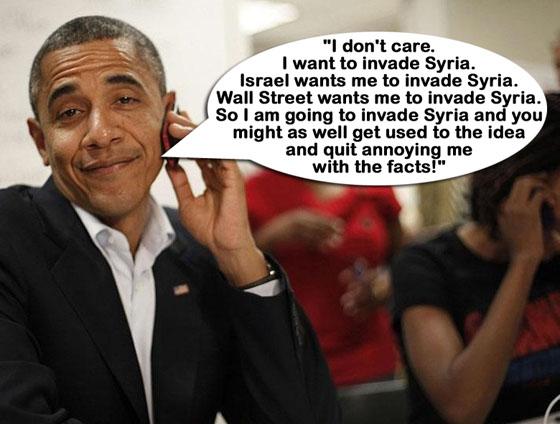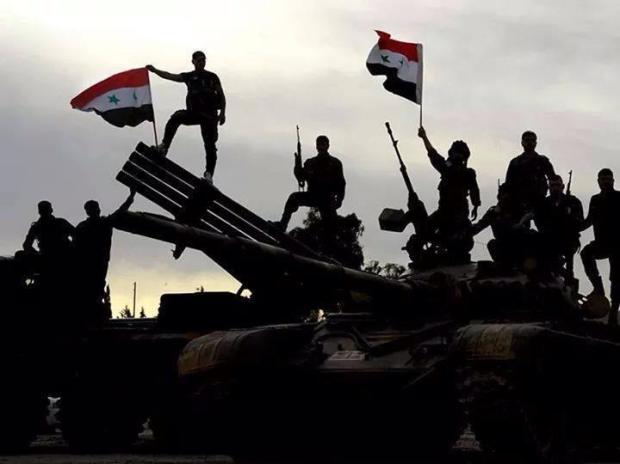Attacks on the Syrian Arab Army have come from all sides, most western media claiming it has been ‘brutal’, defends a ‘dictatorship’ or represents an ‘Alawite regime’. While the army has confronted violence with violence, a series of ‘false flag’ accusations have been levelled at it, the most recent over the use of sarin gas.
However, in defence of this army, I ask two questions: one, after two years of foreign backed attacks, mostly from religious-fanatics, how would secular Syria have survived without its national army? and two, what legitimate function does any army have, if not to defend a nation from foreign backed attempts to violently dismantle the state and constitution or, alternatively, to partition the country?
To properly understand the gravity of the attacks on the secular Syrian state we have to appreciate that all violent insurrections in Syria in the post-colonial period have come from the Muslim Brotherhood’s attempts to impose a form of political Islam, dismantling a secular Arab nationalism established by the Baathist system. The idea of a ‘secular’ uprising is simply a convenient western myth.
Indeed, the major regional competition has been between secular nationalism and political Islam. When Egypt’s Gamel Abdul Nasser was the great hero of the former, the big powers promoted the Saudi monarchy as the Islamic alternative.
 In Daraa in March 2011, just as in Hama in February 1982, the Syrian Muslim Brotherhood seized its opportunity for violent insurrection. Their opening gambit was the same: rooftop snipers killed police and civilians, the army was drawn in and then blamed for ‘killing civilians’, leading to cries for foreign assistance. In the recent conflict, thousand of foreign fundamentalists have been flocking to Syria (mostly paid by the Saudis and Qatar) precisely because it is seen as a religious, and not a national, conflict.
In Daraa in March 2011, just as in Hama in February 1982, the Syrian Muslim Brotherhood seized its opportunity for violent insurrection. Their opening gambit was the same: rooftop snipers killed police and civilians, the army was drawn in and then blamed for ‘killing civilians’, leading to cries for foreign assistance. In the recent conflict, thousand of foreign fundamentalists have been flocking to Syria (mostly paid by the Saudis and Qatar) precisely because it is seen as a religious, and not a national, conflict.
 A 28 March 2011 statement by Muhammad Riyad Al-Shaqfa, Syrian Muslim Brotherhood boss, leaves no doubt that their aim is sectarian, the enemy is ‘the secular regime’ and that ‘we have to make sure that the revolution will be pure Islamic, and with that no other sect would have a share of the credit after its success’.
A 28 March 2011 statement by Muhammad Riyad Al-Shaqfa, Syrian Muslim Brotherhood boss, leaves no doubt that their aim is sectarian, the enemy is ‘the secular regime’ and that ‘we have to make sure that the revolution will be pure Islamic, and with that no other sect would have a share of the credit after its success’.
Amongst current western media clichés is one that the Syrian conflict is becoming ‘increasingly sectarian’. This is linked to simple characterisations of the conflict as one ‘between Sunni and Shia’, or ‘between the majority Sunni community and the Alawite regime’. These clichés are quite misleading.
The Muslim Brotherhood, for historical reasons (mainly its competition with secular Arab nationalism and dependence on Saudi sponsorship) has long represented a particular extremist sect within Sunni Islam. In doctrinal terms this is a salafism which makes use of ‘takfiri’ ideas, by which all other sects can be considered apostates or unbelievers (infidels, kafir) and, for that reason, open to attack. This is an extreme sectarianism which in Syria has given birth to the genocidal, salafi slogan ‘Alawis to the grave, Christians to Beirut’. The FSA has acted on this.
Yet this is not a ‘Sunni’ view. Opinion polls in Syria and around the world show that Sunnis, including conservative Sunnis, are inclined to be tolerant to people of other faiths. A recent Pew Research Centre poll found that, while strong Muslim majorities in many countries support sharia to be ‘the official law of the land’; similarly strong majorities also support freedom of religion for people of other faiths.
Syria’s secular nationalism, enforced by the Baathist regime but reinforced by Shami or Damascene Islam traditions, has nurtured a powerful ecumenicism which sees Christians recognise Ramadan and Muslims recognise Easter. In other words, Syria, on the cross roads of civilisations, has an even stronger tolerant tradition than others.
This is a great problem for the Muslim Brotherhood, which has relied on ‘takfiri’ ideas to advance its political cause. The Brotherhood dominates both the exile ‘opposition’ and the armed groups which make up the ‘Free Syrian Army’, and does have some support amongst the Sunni merchant classes. But it relies on sectarianism. It is the Brotherhood, along with its foreign and Al Qaeda linked allies, that has promoted the idea of the Assad government as ‘an Alawite regime’, murdering Alawi and Shiia civilians, in attempts to incite wider community conflict.

The Brotherhood pretends to represent all Sunnis, or at least ‘real Sunnis’. In practice most Sunnis reject them. The western media reported a series of FSA commanders in Aleppo (an overwhelmingly Sunni city) complaining about lack of support from the local people. ‘I know they hate us’ one told The Guardian, while Time magazine reported another saying: ‘The Aleppans here, all of them, are loyal to the criminal Bashar, they inform on us’. This was later confirmed by a report carried out for NATO which estimated that 70% of the Syrian population backed President Assad, and that much of this support came from secular Sunnis who were horrified by FSA atrocities.
The Syrian state, whatever its other flaws, has certainly represented a strong secular tradition. There are many signs of this. President Bashar al Assad himself is married to a Sunni woman.
The Grand Mufti of Syria, Sheikh Ahmad Hassoun, is a strong Sunni supporter of the secular state. Sheikh Mohamad Al Bouti, murdered along with 42 others by an FSA suicide bomber in March 2013, was a senior Sunni Koranic scholar who backed the secular state. The western media tag on these men as being ‘pro-Assad’ rather misses the point.
Syria’s secular tradition is nowhere stronger than in the Syrian Arab Army. Making up about 80% of Syria’s armed forces and with half a million members, half regulars and half conscripts, the army is drawn from all the country’s communities (Sunni, Alawi, Shiia, Christian, Druze, Kurd, Armenian, etc). However they identify as ‘Syrian’ and ‘Arab’ and confront a sectarian enemy which brands itself ‘real Sunnis’.
A key objective of the Brotherhood’s insurrection was always to split the Syrian Arab Army, along sectarian lines. Indeed, a number of army officers did defect, mostly those with family links to the Brotherhood. FSA atrocities against Alawis and Christians (most of which were blamed on the government), must have raised community feelings. However, towards the end of 2011 the FSA-aligned spokesperson in England Rami Abdel Rahman, who calls himself the Syrian Observatory for Human Rights, said less than 1000 soldiers had deserted.
By mid 2013, more than two years into a bloody conflict, it is quite clear that the army has not fractured on sectarian lines. They have held together as a national force, very clear that they are facing sectarian and often foreign opponents.
The entry of Lebanon’s Hezbollah into the fighting to re-take the town of al-Qusayr hardly represented a sectarian turn in the fighting. Hezbollah, with many allied Shiia communities close to al-Qusayr, was fighting alongside a secular Syrian Arab Army and in defence of the secular Syrian state. Indeed Hezbollah, while Shiia Islamist, also supports a secular (or at least pluralist) state in Lebanon. Through its alliance with Lebanon’s largest Christian group (led by Michel Aoun) it now forms part of the Lebanese government. Hezbollah rejects the salafis’ ‘takfiri’ ideas.
So when commentators claim the Syrian conflict is becoming ‘increasingly sectarian’, they are simply paying more attention to Muslim Brotherhood arguments and ignoring the fact that, across the region, secular nationalism remains an important force.
The ‘elephant in the room’ in this discussion has been the big powers: the USA, Britain, France and Israel, and their collaborators Turkey and the gulf monarchies. The sad reality is that, through their various interventions in the region (Afghanistan, Iraq, Libya) these powers have been using the most reactionary sects within Islam to divide the peoples of the region. If this seems to contradict publicly-stated doctrine, Israel defence official Amos Gilad has made it clear that al-Qaeda elements creating chaos in Syria are far preferable to a united Syria-Iran-Hezbollah axis.
But this discussion has been about the Syrian Arab Army, criticisms of which seem particularly absurd coming from those western countries whose armies spend much of their time invading and occupying a variety of foreign countries, most of them oil-rich, supposedly for the good of the local populace.
Cynics suggest that arbitrary national boundaries and entities created by the colonial powers have no value. However hundreds of thousands of young Syrians put their lives on the line every day to defend a nation that gives them identity, education and a range of shared institutions. I suggest that deserves some respect.
The Syrian Arab Army has been vilified by those very same regimes that arm the foreign jihadis and the local sectarians. Yet despite the relentless attacks, this army has held together and is showing strong signs of resuming control of their own country, in service of a secular and socially inclusive state. If that is not the legitimate function of a national army, I don’t know what is.
———-
References
Muhammad Riyad Al-Shaqfa (2011) ‘Muslim Brotherhood Statement about the so-called “Syrian Revolution”’, on The truth About Syria, Muhammad Riyad Al-Shaqfa is the General supervisor for the Syrian Muslim Brotherhood, statement of 28 March, online
The views expressed in this article are the sole responsibility of the author and do not necessarily reflect those of the Blog!


.jpg)


















